Monday, August 21, 2017 will mark the first total eclipse in the contiguous United States since 1979, and it even has a special name – the Great American Eclipse. It looks to be promising more drama than we usually see around eclipse times, which according to astrology reflect extended periods of intensity and unrest in the world and especially in the areas they cross over! An entire industry is sprouting up from coast-to-coast as people from all over the world are planning to see it. At least one million people are expected to view it from Oregon, where it will first touch down around 9:06 AM PDT (with totality from 10:19-10:21 AM PDT).
According to GreatAmericanEclipse.com, even though “the rest of the United States offers a longer duration of totality, sections of the eclipse path in Oregon offer the best weather prospects anywhere along the entire eclipse path.” Rural areas in Oregon and other parts of the country will be jam-packed, leading to some potentially dangerous situations. Hotels and campgrounds along the path of totality have been booked up far in advance, and residents in these areas are renting their homes for exorbitant amounts of money. It will be peak wildfire season in the West, which makes this even more ominous, thus causing state, local and federal authorities in many areas to coordinate plans and run emergency response simulations.
Visitors and residents are being warned to stock up on emergency supplies (especially food and water) as supply routes will likely be held up for days on end and some people will be likely to get stranded. A friend of mine in Ketchum, Idaho told me that 30-40,000 visitors are expected in her small town of 4,000 which has only two gas stations and two grocery stores. This same story is repeating itself across the country. This will probably be one of the most viewed eclipses in history: Michael Zeiler at Great American Eclipse has estimated that 127.5 million or 39% of Americans live within 300 miles of the path of eclipse totality, and that 12.2 million people live within the path, and that 88 million live within 200 miles – which is easy driving distance. But of course it is impossible to know how many million will travel on that day. It may be a lot since this is happening at the height of summer vacation season and because it’s such a hyped up event, kind of like Y2K, only bigger.
The Great American Eclipse is a big deal to a lot of people because it is such a rare event. The last solar eclipse in America in 1979 was a dud since it occurred in just five states in the Northwest under the bleak sky of their winter. The last coast-to-coast total solar eclipse in America was in 1918, and the next one will be in 2024 in Mexico and the Eastern USA and Canada. In August 12, 2045, there will be another total eclipse with a similar path of totality but lasting over twice as long. The strange thing about this year’s “Great American Eclipse” hullabaloo is that it isn’t even going to last long! The maximum duration of totality will only be 2 minutes and 40 seconds.
Here’s the February 26, 1979 eclipse map: Here’s the June 8, 1918 total solar eclipse map:
Here’s the June 8, 1918 total solar eclipse map: Here are the August 21, 2017 total solar eclipse maps:
Here are the August 21, 2017 total solar eclipse maps:
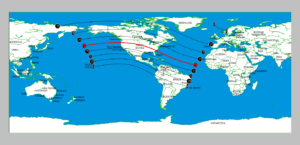
 Here’s the April 8, 2024 eclipse map:
Here’s the April 8, 2024 eclipse map:
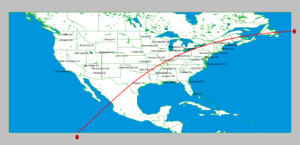 And here’s August 12, 2045 showing the USA eclipse focused on the Southwest:
And here’s August 12, 2045 showing the USA eclipse focused on the Southwest:
 In the Great American Eclipse, the Moon’s umbral shadow will soar across the USA at an average speed of about 1700 miles/hour (~2700 km/hour), covering almost 2500 miles (~4,000 km) in just around an hour-and-a-half. The sky will go dark for just a few minutes during daylight. The path of totality will be about 70 miles wide beginning in Oregon and ending in South Carolina, stretching through Idaho, Wyoming, Nebraska, Kansas, Missouri, Illinois, Kentucky, Tennessee, Georgia, and North Carolina. A partial solar eclipse will be seen from the much broader path of the Moon’s penumbra over all of the USA including Alaska and Hawaii, Canada, western Europe, North/East Asia (Russia), North/West Africa, the northern part of South America, the Pacific Ocean (Hawaii), and the Atlantic and Arctic Oceans.
In the Great American Eclipse, the Moon’s umbral shadow will soar across the USA at an average speed of about 1700 miles/hour (~2700 km/hour), covering almost 2500 miles (~4,000 km) in just around an hour-and-a-half. The sky will go dark for just a few minutes during daylight. The path of totality will be about 70 miles wide beginning in Oregon and ending in South Carolina, stretching through Idaho, Wyoming, Nebraska, Kansas, Missouri, Illinois, Kentucky, Tennessee, Georgia, and North Carolina. A partial solar eclipse will be seen from the much broader path of the Moon’s penumbra over all of the USA including Alaska and Hawaii, Canada, western Europe, North/East Asia (Russia), North/West Africa, the northern part of South America, the Pacific Ocean (Hawaii), and the Atlantic and Arctic Oceans.
 A solar eclipse occurs when the Moon passes between the Sun and Earth, and the Moon fully or partially blocks the Sun. This can happen only at new Moon when the Sun and the Moon are aligned longitudinally as seen from Earth, which is called syzygy. In a total eclipse, the disk of the Sun is fully obscured by the Moon. In partial and annular eclipses, only part of the Sun is covered. Astrology considers a solar eclipse to be a super-charged new Moon, and the total eclipse is the most super-charged of all. It has an effect on the whole world but is considered to be especially significant in the geographical area where it falls.
A solar eclipse occurs when the Moon passes between the Sun and Earth, and the Moon fully or partially blocks the Sun. This can happen only at new Moon when the Sun and the Moon are aligned longitudinally as seen from Earth, which is called syzygy. In a total eclipse, the disk of the Sun is fully obscured by the Moon. In partial and annular eclipses, only part of the Sun is covered. Astrology considers a solar eclipse to be a super-charged new Moon, and the total eclipse is the most super-charged of all. It has an effect on the whole world but is considered to be especially significant in the geographical area where it falls.
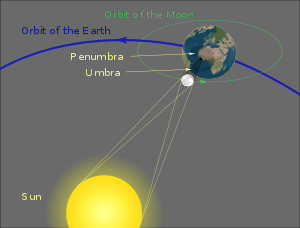 Also important in astrological analysis is to note where the planets in the eclipse chart are angular on the Earth, and how they align with particular mundane and individual horoscopes. For now, I will say that this eclipse, being a Rahu (North Node) Solar Eclipse, can signify new beginnings, expansion, and courage to allow new growth. This can bring the feeling of breakthrough or breakdown depending on our circumstances and how the eclipse affects our natal chart. The impact may initially be distressing as old paradigms may collapse to allow for the opening of something new.
Also important in astrological analysis is to note where the planets in the eclipse chart are angular on the Earth, and how they align with particular mundane and individual horoscopes. For now, I will say that this eclipse, being a Rahu (North Node) Solar Eclipse, can signify new beginnings, expansion, and courage to allow new growth. This can bring the feeling of breakthrough or breakdown depending on our circumstances and how the eclipse affects our natal chart. The impact may initially be distressing as old paradigms may collapse to allow for the opening of something new.
 I will be writing another article about my research and some potential astrological effects of the solar eclipse as well as of the lunar eclipse preceding it on August 7, so please stay tuned! For now I wanted to just focus on what and where it is, and also wanted to weigh in on what I think about viewing it and certain effects and procedures to consider. Ancient Vedic and Puranic texts give certain guidelines for what to do and not do around and during an eclipse because the energy at this time can be possibly agitating, disturbing, and weakening, as the celestial lights (Sun and Moon) are temporarily cut off. Animals and birds are especially sensitive in the hours around the eclipse.
I will be writing another article about my research and some potential astrological effects of the solar eclipse as well as of the lunar eclipse preceding it on August 7, so please stay tuned! For now I wanted to just focus on what and where it is, and also wanted to weigh in on what I think about viewing it and certain effects and procedures to consider. Ancient Vedic and Puranic texts give certain guidelines for what to do and not do around and during an eclipse because the energy at this time can be possibly agitating, disturbing, and weakening, as the celestial lights (Sun and Moon) are temporarily cut off. Animals and birds are especially sensitive in the hours around the eclipse.
 It is advised not to visit temples or to worship or tend to idols, and not to consume food or water during the eclipse, and yogis will observe these kinds of niyamas for up to 12 hours before and afterward. We are told to avoid sleeping, sexual activities, and unnecessary talking for the duration of the eclipse. It is a time when no important outer work should be performed. In fact, according to Muhurta, nothing of lasting material value should be initiated for three days before or three days after an eclipse.
It is advised not to visit temples or to worship or tend to idols, and not to consume food or water during the eclipse, and yogis will observe these kinds of niyamas for up to 12 hours before and afterward. We are told to avoid sleeping, sexual activities, and unnecessary talking for the duration of the eclipse. It is a time when no important outer work should be performed. In fact, according to Muhurta, nothing of lasting material value should be initiated for three days before or three days after an eclipse.
In Aghora II: Kundalini, Dr. Robert Svoboda discusses eclipses according to what he learned from the late great Aghori Vimalananda who said that we should “never look at an eclipse as the rays have a disturbing effect on the mind” and this includes not even looking with special protective eclipse glasses. And he also warned that “a pregnant woman should not go outside, lest her [unborn] child be affected.” Sri Vimalananda also mentioned positive spiritual effects of eclipses through “strange gravitational effects” that “multiply the effect of our sadhana [spiritual practice]: If you do one hundred repetitions of your mantra during an eclipse it is like doing one hundred thousand repetitions on an ordinary day. If you offer one oblation into the fire it is like a thousand oblations. And nothing beats this time for offering prayers and performing rites for your deceased ancestors.”
 As above, so below…as within, so without, thus the Sun and Moon correspond to our higher chakras (cakras), which are also being activated, as in rebooted, during eclipses which stimulate not only our sublime energetic systems but also our endocrine and neurological systems. The pituitary “master endocrine gland” of the body is connected to the Moon per yogic astrology (and to “the third eye” ajna chakra), and produces a series of hormones that either control most of the other glands in the body or have a direct effect on specific organs. The pineal gland is the “seat of the soul” and is connected to the Sun according to yogic astrology (as well as to the Sahasrara “crown” chakra), and regulates mood, sleep, and energy levels. During eclipses, the electromagnetic shields go down allowing higher cosmic energies to come in and reset all these systems. So you can see why it is such a sensitive time and why wise spiritual masters suggest we use it to our advantage.
As above, so below…as within, so without, thus the Sun and Moon correspond to our higher chakras (cakras), which are also being activated, as in rebooted, during eclipses which stimulate not only our sublime energetic systems but also our endocrine and neurological systems. The pituitary “master endocrine gland” of the body is connected to the Moon per yogic astrology (and to “the third eye” ajna chakra), and produces a series of hormones that either control most of the other glands in the body or have a direct effect on specific organs. The pineal gland is the “seat of the soul” and is connected to the Sun according to yogic astrology (as well as to the Sahasrara “crown” chakra), and regulates mood, sleep, and energy levels. During eclipses, the electromagnetic shields go down allowing higher cosmic energies to come in and reset all these systems. So you can see why it is such a sensitive time and why wise spiritual masters suggest we use it to our advantage.
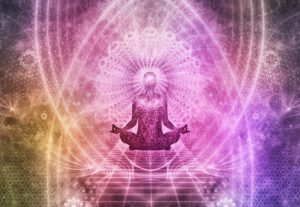 According to Lama Zopa Rinpoche, the effects of our positive and negative actions are multiplied in eclipses. In terms of the positive, he says that both lunar and solar eclipses are auspicious days for practice and provide opportunities for accumulating increased merit which is multiplied by 700,000 for lunar eclipses, and 100 million for solar. On these multiplying days, any beneficial spiritual practices or ceremonies can be done. So based on all this, I personally don’t care to go outside and view eclipses. I will stay inside and go within myself during the eclipse(s) to do my prayers and meditation that align me with the higher cosmic frequencies coming in.
According to Lama Zopa Rinpoche, the effects of our positive and negative actions are multiplied in eclipses. In terms of the positive, he says that both lunar and solar eclipses are auspicious days for practice and provide opportunities for accumulating increased merit which is multiplied by 700,000 for lunar eclipses, and 100 million for solar. On these multiplying days, any beneficial spiritual practices or ceremonies can be done. So based on all this, I personally don’t care to go outside and view eclipses. I will stay inside and go within myself during the eclipse(s) to do my prayers and meditation that align me with the higher cosmic frequencies coming in.
The best time for spiritual practices in the August 7, 2017 lunar eclipse window will be 1:23 PM EDT to 3:18 PM EDT / 5:23 PM UTC to 7:18 PM UTC, with the maximum time occurring around 2:10-2:20 PM EDT / 6:10-6:20 PM UTC.
The best time for spiritual practices in the solar eclipse window will be August 21, 2017 from 1:19 PM EDT to 2:45 PM EDT / 5:19 PM UTC to 6:45 PM UTC with the most potent time being 2:25-2:30 PM EDT / 6:25-6:30 PM UTC: (a) the maximum eclipse time occurs at 2:25 PM EDT / 6:25 PM UTC, and (b) the exact lunar phase/new Moon occurs at 2:30 PM EDT / 6:30 PM UTC.
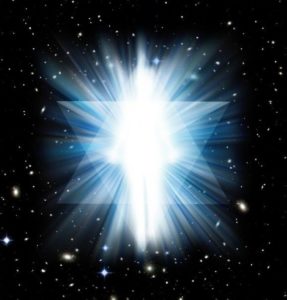 For more information, here are some of my favorite eclipse websites which include interactive maps:
For more information, here are some of my favorite eclipse websites which include interactive maps:
- https://eclipse2017.nasa.gov/
- http://www.eclipse2017.org/2017/path_through_the_US.htm
- https://www.greatamericaneclipse.com/
- https://www.space.com/33797-total-solar-eclipse-2017-guide.html
- http://www.skyandtelescope.com/2017-total-solar-eclipse/
- https://www.timeanddate.com/eclipse/solar/2017-august-21
